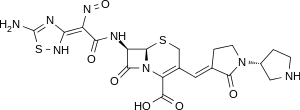Ceftobiprole
 | |
| Clinical data | |
|---|---|
| AHFS/Drugs.com | International Drug Names |
| Routes of administration | Intravenous |
| ATC code | |
| Legal status | |
| Legal status |
|
| Identifiers | |
| |
| CAS Number |
|
| PubChem CID | |
| ChemSpider | |
| UNII | |
| KEGG | |
| ChEMBL | |
| ECHA InfoCard | 100.129.666 |
| Chemical and physical data | |
| Formula | C20H22N8O6S2 |
| Molar mass | 534.568 g/mol |
| 3D model (JSmol) | |
| |
| |
| | |
Ceftobiprole (Zevtera/Mabelio) is a new 5th-generation[2] cephalosporine for the treatment of hospital-acquired pneumonia (HAP, excluding ventilator-associated pneumonia, VAP) and community-acquired pneumonia (CAP). It is marked by Basilea Pharmaceutica in the United Kingdom, Germany, Switzerland and Austria under the trade name Zevtera, in France and Italy under the trade name Mabelio.[3] Like other cephalosporins, ceftobiprole exerts its antibacterial activity by binding to important penicillin-binding proteins and inhibiting their transpeptidase activity which is essential for the synthesis of bacterial cell walls. Ceftobiprole has high affinity for PBP2a of methicillin-resistant Staphylococcus aureus (MRSA) strains and retains its activity against strains that express divergent mecA gene homologues (mecC or mecALGA251). Ceftobiprole also binds to PBP2b in Streptococcus pneumoniae (penicillin-intermediate), to PBP2x in S. pneumoniae (penicillin resistant), and to PBP5 in Enterococcus faecalis.[4]
Microbiology
Ceftobiprole has shown in vitro antimicrobial activity against a broad range of Gram-positive and Gram-negative pathogens. Among the Gram-positive pathogens, ceftobiprole has demonstrated good in vitro activity against methicillin-resistant Staphylococcus aureus (MRSA), methicillin-susceptible Staphylococcus aureus (MSSA) and coagulase-negative staphylococci, as well as against MRSA strains with reduced susceptibility to linezolid, daptomycin or vancomycin.[5] Ceftobiprole has also displayed potent activity against Streptococcus pneumoniae (including penicillin-sensitive, penicillin-resistant and ceftriaxone-resistant strains) and Enterococcus faecalis, but not against Enterococcus faecium. For Gram-negative pathogens, ceftobiprole has shown good in vitro activity against Haemophilus influenzae (including both ampicillin-susceptible and ampicillin-non-susceptible isolates), Pseudomonas aeruginosa and strains of Escherichia coli, Klebsiella pneumoniae and Proteus mirabilis not producing extended-spectrum β-lactamase (ESBL). Like all other cephalosporines, ceftobiprole was inactive against ESBL producing strains.[6]
The efficacy of ceftobiprole has been demonstrated in two large randomized, double-blind, phase 3 clinical trials in patients with HAP and CAP. Ceftobiprole was non-inferior to ceftazidime plus linezolid in the treatment of HAP (excluding VAP) and non-inferior to ceftriaxone with or without linezolid in the treatment of CAP.[7][8]
Pharmacology
(1)_(30204271666).jpg)
Ceftobiprole is the active moiety of the prodrug ceftobiprole medocaril and is available for i.v. treatment only. The recommended dose is 500 mg as 2-hour infusion every 8 hours. It is mainly excreted renally. Dose adjustment is required for patients with moderate or severe renal impairment and for patients with end-stage renal disease, but no dose adjustment is needed by gender, ethnicity or age, in severely obese patients or in patients with hepatic impairment.[9]
Regulatory approvals
(1)_(29608654394).jpg)
Ceftobiprole has been approved for the treatment of adult patients with hospital acquired pneumonia (excluding VAP) and community acquired pneumonia in 12 European countries, Canada and Switzerland.[10]
Synonyms
References
- ↑ WHO International Working Group for Drug Statistics Methodology (August 27, 2008). "ATC/DDD Classification (FINAL): New ATC 5th level codes". WHO Collaborating Centre for Drug Statistics Methodology. Archived from the original on 2008-05-06. Retrieved 2008-09-05.
- ↑ Scheeren, Thomas W. L. (2015-01-01). "Ceftobiprole medocaril in the treatment of hospital-acquired pneumonia". Future Microbiology. 10 (12): 1913–1928. ISSN 1746-0921. PMID 26573022. doi:10.2217/fmb.15.115.
- ↑ "Basilea to launch Zevtera®/Mabelio® (ceftobiprole medocaril) in Europe through a commercial services provider". Basilea Pharmaceutica.
- ↑ Syed, Yahiya Y. (2014-09-01). "Ceftobiprole medocaril: a review of its use in patients with hospital- or community-acquired pneumonia". Drugs. 74 (13): 1523–1542. ISSN 0012-6667. PMID 25117196. doi:10.1007/s40265-014-0273-x.
- ↑ Zhanel GG, Lam A, Schweizer F, Thomson K, Walkty A, Rubinstein E, Gin AS, Hoban DJ, Noreddin AM, Karlowsky JA (2008). "Ceftobiprole: a review of a broad-spectrum and anti-MRSA cephalosporin.". Am J Clin Dermatol. 9: 245–54. PMID 18572975. doi:10.2165/00128071-200809040-00004.
- ↑ Farrell, David J.; Flamm, Robert K.; Sader, Helio S.; Jones, Ronald N. (2014-07-01). "Ceftobiprole activity against over 60,000 clinical bacterial pathogens isolated in Europe, Turkey, and Israel from 2005 to 2010". Antimicrobial Agents and Chemotherapy. 58 (7): 3882–3888. ISSN 1098-6596. PMC 4068590
 . PMID 24777091. doi:10.1128/AAC.02465-14.
. PMID 24777091. doi:10.1128/AAC.02465-14. - ↑ Farrell, David J.; Flamm, Robert K.; Sader, Helio S.; Jones, Ronald N. (2014-04-01). "Activity of ceftobiprole against methicillin-resistant Staphylococcus aureus strains with reduced susceptibility to daptomycin, linezolid or vancomycin, and strains with defined SCCmec types". International Journal of Antimicrobial Agents. 43 (4): 323–327. ISSN 1872-7913. PMID 24411474. doi:10.1016/j.ijantimicag.2013.11.005.
- ↑ Nicholson, Susan C.; Welte, Tobias; File, Thomas M.; Strauss, Richard S.; Michiels, Bart; Kaul, Pratibha; Balis, Dainius; Arbit, Deborah; Amsler, Karen (2012-03-01). "A randomised, double-blind trial comparing ceftobiprole medocaril with ceftriaxone with or without linezolid for the treatment of patients with community-acquired pneumonia requiring hospitalisation". International Journal of Antimicrobial Agents. 39 (3): 240–246. ISSN 1872-7913. PMID 22230331. doi:10.1016/j.ijantimicag.2011.11.005.
- ↑ Awad, Samir S.; Rodriguez, Alejandro H.; Chuang, Yin-Ching; Marjanek, Zsuszanna; Pareigis, Alex J.; Reis, Gilmar; Scheeren, Thomas W. L.; Sánchez, Alejandro S.; Zhou, Xin (2014-07-01). "A phase 3 randomized double-blind comparison of ceftobiprole medocaril versus ceftazidime plus linezolid for the treatment of hospital-acquired pneumonia". Clinical Infectious Diseases. 59 (1): 51–61. ISSN 1537-6591. PMC 4305133
 . PMID 24723282. doi:10.1093/cid/ciu219.
. PMID 24723282. doi:10.1093/cid/ciu219. - ↑ Basilea Medical Ltd. Summary of Product Characteristics: Zevtera 500 mg powder for concentrate for solution for infusion. Medicines and Healthcare Products Regulatory Agency. http://www.mhra.gov.uk/spc
- ↑ Hebeisen P, Heinze-Krauss I, Angehrn P, et al. (2001). "In vitro and in vivo properties of Ro63-9141, a novel broad-spectrum cephalosporin with activity against methicillin-resistant staphylococci". Antimicrob Agents Chemother. 45 (3): 825–36. PMC 90381
 . PMID 11181368. doi:10.1128/AAC.45.3.825-836.2001.
. PMID 11181368. doi:10.1128/AAC.45.3.825-836.2001. - ↑ Jones RN, Deshpande LM, Mutnick AH, Biedenbach DJ (2002). "In vitro evaluation of BAL9141, a novel parenteral cephalosporin active against oxacillin-resistant staphylococci". J Antimicrob Chemother. 50 (6): 915–932. PMID 12461013. doi:10.1093/jac/dkf249.